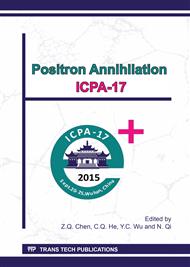p.241
p.245
p.249
p.257
p.261
p.265
p.269
p.274
p.280
On the Limits of Sensitivity of PALS to Incorporated Free Volume Holes in Polymeric Membranes and Sorbents: Effect of sc-CO2 in Polyhexafluoropropylene
Abstract:
Positron annihilation lifetime spectroscopy (PALS) is a recognized instrument for the studies of size-distribution of nanopores (intrinsic free volume holes FVH) in polymers, particularly membrane materials. The limits of this application in the case of “alien” pores, produced by swelling of poly (hexafluoro propylene) PHFP in the gas (CO2) in super-critical (sc-) state are discussed. The obtained conclusions are controlled by measurements of low temperature gas (N2) sorption (LTGS) and by comparison of the data with the results on permeation of various gases through the PHFP membrane. Attention is payed to relaxation with time of the newly created FVH in the PHFP membrane.
Info:
Periodical:
Pages:
261-264
Citation:
Online since:
March 2017
Keywords:
Price:
Сopyright:
© 2016 Trans Tech Publications Ltd. All Rights Reserved
Share:
Citation:


